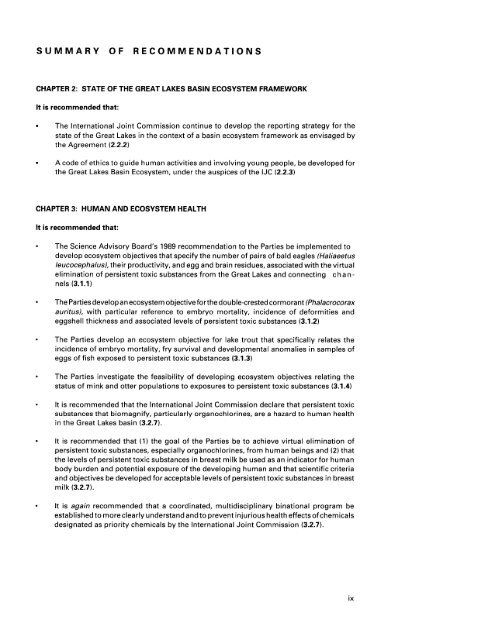International Joint Commission
International Joint Commission
International Joint Commission
Create successful ePaper yourself
Turn your PDF publications into a flip-book with our unique Google optimized e-Paper software.
SUMMARY OF RECOMMENDATIONS<br />
CHAPTER 2: STATE OF THE GREAT LAKES BASIN ECOSYSTEM FRAMEWORK<br />
It is recommended that:<br />
The <strong>International</strong> <strong>Joint</strong> <strong>Commission</strong> continue to develop the reporting strategy for the<br />
state of the Great Lakes in the context of a basin ecosystem framework as envisaged by<br />
the Agreement (2.2.2)<br />
A code of ethics to guide human activities and involving young people, be developed for<br />
the Great Lakes Basin Ecosystem, under the auspices of the IJC (2.2.3)<br />
CHAPTER 3: HUMAN AND ECOSYSTEM HEALTH<br />
It is recommended that:<br />
The Science Advisory Board's 1989 recommendation to the Parties be implemented to<br />
develop ecosystem objectives that specify the number of pairs of bald eagles (Haliaeetus<br />
leucocephalus), their productivity, and egg and brain residues, associated with the virtual<br />
elimination of persistent toxic substances from the Great Lakes and connecting channels<br />
(3.1.1)<br />
The Parties develop an ecosystem objective forthe double-crested cormorant (Phalacrocorax<br />
auritus), with particular reference to embryo mortality, incidence of deformities and<br />
eggshell thickness and associated levels of persistent toxic substances (3.1.2)<br />
The Parties develop an ecosystem objective for lake trout that specifically relates the<br />
incidence of embryo mortality, fry survival and developmental anomalies in samples of<br />
eggs of fish exposed to persistent toxic substances (3.1.3)<br />
The Parties investigate the feasibility of developing ecosystem objectives relating the<br />
status of mink and otter populations to exposures to persistent toxic substances (3.1.4)<br />
.<br />
It is recommended that the <strong>International</strong> <strong>Joint</strong> <strong>Commission</strong> declare that persistent toxic<br />
substances that biornagnify, particularly organochlorines, are a hazard to human health<br />
in the Great Lakes basin (3.2.7).<br />
It is recommended that (1) the goal of the Parties be to achieve virtual elimination of<br />
persistent toxic substances, especially organochlorines, from human beings and (2) that<br />
the levels of persistent toxic substances in breast milk be used as an indicator for human<br />
body burden and potential exposure of the developing human and that scientific criteria<br />
and objectives be developed for acceptable levels of persistent toxic substances in breast<br />
milk (3.2.7).<br />
It is again recommended that a coordinated, multidisciplinary binational program be<br />
established to moreclearly understand and to prevent injurious health effectsof chemicals<br />
designated as priority chemicals by the <strong>International</strong> <strong>Joint</strong> <strong>Commission</strong> (3.2.7).<br />
ix

















